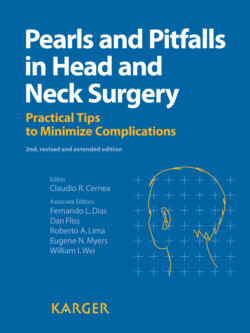Читать книгу Pearls and Pitfalls in Head and Neck Surgery - Группа авторов - Страница 17
На сайте Литреса книга снята с продажи.
ОглавлениеThyroid and Parathyroid Glands
Cernea CR, Dias FL, Fliss D, Lima RA, Myers EN, Wei WI (eds): Pearls and Pitfalls in Head and Neck Surgery. Basel, Karger, 2012, pp 22–23
DOI: 10.1159/000338064
1.11 Practical Tips for the Surgical Management of Secondary Hyperparathyroidism
Fábio Luiz de Menezes Montenegroa Rodrigo Oliveira Santosb Anói Castro Cordeiroa
aDepartment of Head and Neck Surgery, University of São Paulo Medical School, and bDepartment of Otolaryngology- Head and Neck Surgery, Federal University of São Paulo, São Paulo, Brazil
P E A R L S
• Ultrasound may be helpful to disclose associated thyroid disorders or intrathyroidal parathyroid glands.
• Intraoperative parathyroid hormone (PTH) monitoring may indicate a supernumerary hyperfunctioning gland.
• Implanting cryopreserved parathyroid tissue may correct postoperative hypoparathyroidism.
P I T F A L L S
• Not all patients with chronic kidney disease (CKD) and elevation of PTH levels are candidates for para-thyroidectomy.
• Hypocalcemia may develop after parathyroidectomy due to hungry bone syndrome.
• Postoperative decrease of renal graft function may occur in some cases with tertiary hyperparathyroidism (3HPT).
• Autotransplantation of nodular areas increases the chance of graft-related recurrence.
Introduction
Parathyroid hyperfunction due to a previous metabolic derangement is characterized as secondary hyperparathyroidism (2HPT). The most frequent cause is CKD.
As renal function decreases, PTH increases. Mild elevation of PTH level is necessary for adequate bone metabolism in patients with CKD. However, parathyroid autonomy causes excessive secretion of PTH and is associated with deleterious effects.
Besides fractures and bone pain, it is well recognized that other mineral metabolism derangements are important to morbidity and mortality of renal patients, with an increased risk of cardiovascular events [1].
The denomination 3HPT is usually employed in patients with hyperparathyroidism after successful kidney transplantation. In the text below, 2HPT will refer to patients with CKD under dialysis and 3HPT will be restricted to renal transplant cases.
Practical Tips
Indication of Parathyroidectomy. Under specific conditions, parathyroidectomy will significantly improve quality of life and prolong survival. In 2HPT, the Guidelines of the Kidney Disease Improving Global Outcomes (KDIGO) establish that in patients with CKD stage V on dialysis, PTH levels should be 2-9 times the upper normal limit to the assay. Parathyroidectomy is recommended in patients who fail medical therapy [2]. In 3HPT, increased PTH and persistent hypercalcemia after kidney transplantation suggests that parathyroidectomy is required.
Preoperative Imaging. Preoperative ultrasound and technetium-sestamibi (MIBI) scanning are very important. Ultrasound may indicate associated thyroid disease, such as papillary thyroid carcinoma [3], and intrathyroidal parathyroid glands [4]. MIBI scan usually does not detect all hyperfunctioning glands, but it may indicate ectopic glands.
Preoperative Care. Comorbidities are common and they must be evaluated before surgery. Dialysis is performed the day before the operation, and a lower heparin dose is advised.
Intraoperative Care. Nephrotoxic drugs and hypotension must be avoided in patients with 3HPT. If feasible, intraoperative PTH should be employed. Reduction of 80% of basal levels after 10-20 min seems to indicate an adequate excision and rule out a hyperfunctioning supernumerary parathyroid [5].
Extent of Surgery. There is no consensus in the literature about the best approach for 2HPT and 3HPT. Subtotal parathyroidectomy and total parathyroidectomy with immediate heterotopic autotransplantation have been reported with good results. Forearm and presternal autotransplantation are acceptable techniques. Areas of nodular hyperplasia should be avoided for autotransplantation (increased risk of graft-dependent recurrence). The risk of malignant tissue transplantation is rare as parathyroid carcinoma is rather infrequent in both 2HPT and 3HPT [6, 7].
Postoperative Care. Right after the surgery for 2HPT, a continuous infusion of calcium in a small volume saline or dextrose is started. Usually, 900 mg of elemental calcium of calcium gluconate are diluted in 200-250 ml and infused through a central vein. As soon as possible, oral calcium and calcitriol are added in large daily doses (4.0-7.0 g of calcium salts and 24 μg of calcitriol) [8]. Hyperkalemia may require urgent dialysis. In 3HPT, hypocalcemia is less pronounced and lower doses of calcium and calcitriol are required. Chronic hypoparathyroidism may be reversed by autotransplantation of cryopreserved tissue [9]. Renal function should be evaluated closely. There is evidence that acute PTH reduction affects renal function. In our experience, parathyroidectomy does not affect kidney graft function in the long run [10].
References
1 Moorthi RN, Moe SM: CKD-mineral and bone disorder: core curriculum 2011. Am J Kidney Dis 2011;58:1022–1036.
2 KDIGO Guideline for Chronic Kidney Disease-Mineral and Bone Disorder (CKD-MBD). Kidney Int 2009;76(suppl 113):1–140.
3 Montenegro FLM, Smith RB, Castro IV, Tavares MR, Cordeiro AC, Ferraz AR: Association of papillary thyroid carcinoma and hyperparathyroidism. Rev Col Bras Cir 2005;32:115–119.
4 Montenegro FLM, Tavares MR, Cordeiro AC, Ferraz AR, Ianhez LE, Buchpiguel CA: Intrathyroidal supernumerary parathyroid gland in hyperparathyroidism after renal transplantation. Nephrol Dial Transplant 2007;22:293–295.
5 Ohe MN, Santos RO, Kunii IS, Abrahao M, Cervantes O, Carvalho AB, Lazaretti-Castro M, Vieira JG: Usefulness of intraoperative PTH measurement in primary and secondary hyperparathyroidism: experience with 109 patients. Arq Bras Endocrinol Metabol 2006;50:869–875.
6 Cordeiro AC, Montenegro FLM, Kulcsar MAV, Dellanegra LA, Tavares MR, Michaluart P, Ferraz AF: Parathyroid carcinoma. Am J Surg 1998;175:52–55.
7 Montenegro FLM, Tavares MR, Durazzo MD, Cernea CR, Cordeiro AC, Ferraz AR: Clinical suspicion and parathyroid carcinoma management. Sao Paulo Med J 2006;124:42–44.
8 Cozzolino M, Gallieni M, Corsi C, Bastagli A, Brancaccio D: Management of calcium refilling post-parathyroidectomy in end-stage renal disease. J Nephrol 2004;17:3–8.
9 Montenegro FLM, Custódio MR, Arap SS, Reis LM, Sonohara S, Castro IV, Jorgetti V, Cordeiro AC, Ferraz AR: Successful implant of long-term cryopreserved parathyroid glands after total parathyroidectomy. Head Neck 2007;29:296–300.
10 Ferreira GF, Montenegro FL, Machado DJ, Ianhez LE, Nahas WC, David-Neto E: Parathyroidectomy after kidney transplantation: short-and long-term impact on renal function. Clinics (Sao Paulo) 2011;66:431–435.
Dr. Fábio Luiz de Menezes Montenegro,
MD
Rua Apeninos, 1118 ap. 62
São Paulo, SP 04104-021 (Brazil)
E-Mail fabiomonte@uol.com.br
